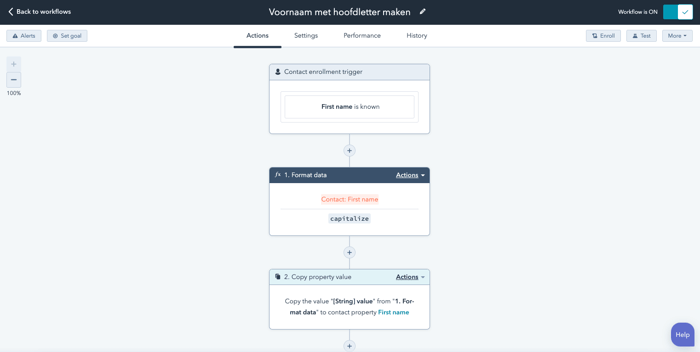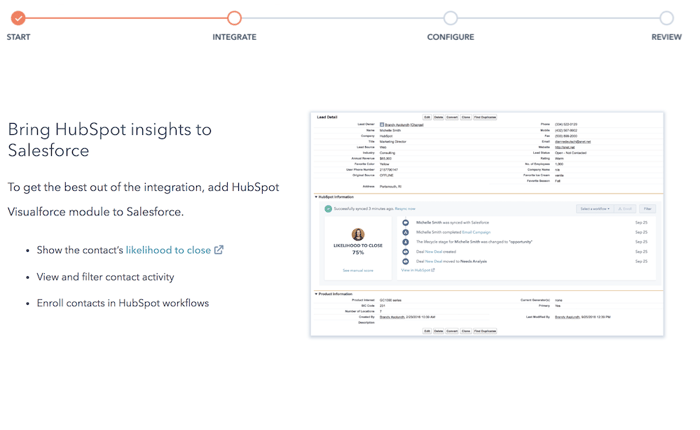A HubSpot implementation isn’t just about switching on a tool. It’s about bringing your teams together, streamlining the way you work, and tailoring the platform so it fits your business like a glove.
In this guide, we break the HubSpot implementation process into eight clear steps, split into two phases: preparation and technical setup. From aligning stakeholders and cleaning your data to configuring integrations and launching with confidence, these steps will help you get the most from your investment and set you up for long-term success.
What Is a HubSpot implementation?
If you’ve never used HubSpot before, think of it as an all-in-one CRM platform that helps you manage and connect your marketing, sales, customer service, and operational activities. It’s designed to give you a complete view of your customers, automate repetitive tasks, and make your teams work more efficiently — all from one place.
A HubSpot implementation is the process of setting up the platform so it’s tailored to your organisation’s needs. This usually involves:
-
Configuring the CRM – setting up contact properties, pipelines, and deal stages
-
Connecting your tools – integrating HubSpot with your website, email, and other systems like Salesforce or ERP software
-
Preparing your data – migrating, cleaning, and organising customer records
-
Building assets – creating email templates, landing pages, forms, and automation workflows
-
Training your team – making sure everyone knows how to use the tools effectively
From our experience, many organisations underestimate the preparation stage.
Preparation stage
The first phase lays the groundwork for everything that follows. It’s where you bring the right people together, agree on your approach, and make sure your data is in order. Skip it, and you risk costly rework, delays, and frustrated users down the line.
Many organisations rush into configuration, only to realise too late that key decisions about processes, responsibilities, and data haven’t been made. Steps 1 to 4 are designed to prevent that — ensuring everyone is aligned, your strategy is clear, and your data is ready for a smooth HubSpot launch.
#1 Build a strong foundation through early planning and collaboration
HubSpot is an investment — whether you’re implementing all Hubs or just a few features. Don’t let the decision rest on one person; broad organisational buy-in is essential. Implementing HubSpot often means a significant change to how your marketing, sales, service, and operations teams work together.
If there are other teams or individuals who will also use HubSpot — such as customer service, operations, or finance — make sure to involve them early. Their input can uncover needs and challenges you might otherwise miss.
Key actions:
-
Plan well in advance – Start weeks or even months before implementation, depending on the scope and features you’ve purchased. This gives all stakeholders time to prepare and align.
-
Form a cross-department steering group – Include representatives from marketing, sales, and IT at minimum, ideally with different roles and perspectives. This ensures every function’s needs are considered.
-
Align marketing and sales early – Marketing will need sales input to design effective campaigns; sales will rely on marketing for pipeline setup and lead management. Define what lead data needs to be collected and how sales teams should receive notifications.
-
Engage IT from the start – IT knows your current systems and integrations. If you use Salesforce or another CRM, they can compare HubSpot’s object structure with your existing setup and flag potential issues non-technical team members might miss.
-
Encourage ongoing communication – Keep brainstorming and sharing ideas throughout the process. Use methods like internal surveys, a digital idea box, and regular updates to communicate how HubSpot will benefit each team.
When everyone is aligned, you’ll avoid surprises, meet expectations, and get exactly what you envisioned out of HubSpot.
#2 Assign a dedicated project ambassador to drive the process
Once multiple stakeholders are involved, you need someone to keep the big picture in sight. This project ambassador is responsible for managing the timeline, ensuring decisions are implemented, and preventing the team from getting lost in details too early.
Key actions:
- Choose someone who can free up at least two days per week for this role
- Ensure they have the authority to assign tasks and hold people accountable
- Give them visibility across departments so they can coordinate effectively
- Communicate their role clearly so all teams know where to go with questions or issues
The ambassador is the visible “face” of the HubSpot implementation and keeps momentum going until (and after) go-live.
#3 Create a content strategy that powers your HubSpot campaigns
HubSpot centralises your marketing, sales, and service activities — but it’s the content that drives engagement. Without a strategy, you risk publishing random pieces that don’t connect to your goals.
Key actions:
- Define the messages and topics you want to communicate
- Decide which content formats you’ll use (blogs, videos, podcasts, email campaigns, events)
- Ensure content covers all funnel stages — from awareness to decision
- Identify content creators — internal staff or external partners like copywriters
- Optimise for the keywords your audience is searching for
- Set measurable goals and track them with HubSpot reports
💡 Related reading article (Dutch): Improve your SEO with HubSpot topic clusters and pillar pages
#4 Clean and prepare your data before migration
Your CRM is the beating heart of your organisation. It holds the most important information about your leads, prospects, and customers — data your marketing, sales, and service teams rely on every day. If that heart gets “clogged” with outdated, incomplete, or duplicate records, it can slow down your entire organisation.
Before moving data into HubSpot, make sure it’s relevant, complete, and consistent. Clean data not only improves reporting accuracy but also helps your teams work faster and with more confidence.
Key actions:
- Remove duplicates – Avoid confusion in follow-up and ensure every contact record is unique.
- Mark essential fields as required – This guarantees that vital information is always captured correctly by your team.
- Standardise formatting – Apply consistent capitalisation and address structures to keep records uniform.
- Use HubSpot’s duplication tool – Leverage built-in features to quickly identify and merge duplicate entries.
- Carefully map fields when migrating from another CRM – Ensure no valuable information is lost and that properties match HubSpot’s structure.

Technical set-up phase
With the preparation complete, it’s time to move into the second phase — the technical setup. This is where you turn plans into a live, working system. You’ll configure HubSpot, connect it to your tools, and set up tracking so you can start capturing and using data effectively.
Steps 5 to 8 focus on getting the platform ready for daily use, ensuring everything is tested, optimised, and fully aligned with your business goals before you go live.
#5 Map custom fields and compare objects
When HubSpot connects with your other tools, it’s crucial to ensure that data moves between them correctly. This is where custom field mapping comes in — defining how information in HubSpot corresponds to fields in another system.
HubSpot allows for different types of syncing:
-
One-way sync – Data flows in a single direction.
-
Two-way sync – Data updates in both systems.
-
Filtered sync – Only specific records or fields are synced.
If you’re integrating HubSpot with Salesforce, for example, you can map HubSpot properties to Salesforce fields for core objects like contacts, companies, and deals. This ensures that when a sales rep updates a phone number in one system, it’s reflected in the other — without overwriting critical information.

Key considerations:
- Review the object types in both HubSpot and your existing CRM to see how they align.
- Decide which fields should sync, in what direction, and under which conditions.
- Test the mapping with a small dataset before going live to avoid large-scale errors.
- Document your mapping rules so the process is transparent and easy to maintain.
💡 Related reading (Dutch): HubSpot migration & consultancy services
#6 Set up HubSpot’s technical foundation for success
This is the stage where your planning turns into a functioning system. The technical setup is essential for enabling tracking, hosting your content, and ensuring your marketing and sales teams can work from one central platform.
Install the HubSpot tracking code – Every HubSpot account has a unique tracking code. Once installed on your website, it records visitor behaviour so you can analyse traffic and engagement. The code is automatically included on HubSpot-hosted content (blog posts, landing pages, website pages), but it must also be added to any external site to get a complete view of your visitors’ journeys.
Configure subdomains – Subdomains (e.g. store.yourcompany.com) help you separate different types of content or functionality. For example, you might host your blog on one subdomain and your event pages on another, making it easier to organise content and maintain a clear structure.
Design high-converting landing pages – Whether you want visitors to purchase a product, download a whitepaper, or register for a webinar, your landing pages should deliver a clear, consistent message in tone, style, and layout. A well-designed page balances persuasive copy with strong UI and UX, guiding the visitor towards action without distraction. The same principles apply to thank-you pages and blog content.
Start lead tracking – This is also the point where you begin monitoring leads’ activity and interactions, allowing your marketing and sales teams to follow up more effectively.
Additional technical steps:
- Connect your social media accounts so you can schedule posts and track engagement from within HubSpot.
- Integrate your blog for centralised publishing and analytics.
- Exclude internal traffic from reports to keep analytics accurate.
- Set up A/B testing to compare different versions of pages or emails and optimise based on performance.
💡 Related reading (Dutch): A/B testing in HubSpot
#7 Test, review, and refine before going live
Once your technical setup is in place, it’s tempting to hit the launch button — but thorough testing ensures that the system works as intended for both your team and your customers. This stage is about spotting and fixing issues before they affect live campaigns.
Testing tips:
-
Functionality check – Test all workflows, forms, and automations. Do they trigger at the right time? Are notifications sent to the right people?
-
Design and layout review – Make sure spacing, colours, typography, and button styles are consistent and user-friendly.
-
Link verification – Test all internal and external links, ensuring they lead to the right pages.
-
Image and media check – Confirm that images load quickly and display correctly across devices.
-
Readability and UX – Review content length, line spacing, and font size to ensure comfortable reading.
-
Analytics validation – Check that your tracking is correctly recording visits, conversions, and other key metrics.
Extra tip: Involve people from different teams — marketing, sales, and service — in your testing. Fresh perspectives often spot details you might overlook. The more eyes on the system, the greater your chances of catching small issues before they become big problems.
💡 Related reading (Dutch): 7 elements of a high-converting landing page
#8 Consider whether external support could strengthen your implementation
A HubSpot implementation can be a complex process. Even with skilled internal teams, there are common challenges that can slow progress or reduce the quality of the setup.
External support from an experienced, neutral party can help you avoid these pitfalls and ensure a smoother rollout.
Typical scenarios where external guidance can help:
-
Unclear objectives – When business goals haven’t been translated into measurable outcomes, it’s easy to lose direction during setup.
-
Gaps in expertise – Certain features, integrations, or automation workflows may require specialist knowledge your team doesn’t yet have.
-
Internal disagreements – A neutral facilitator can help resolve differences between departments about processes or priorities.
-
Process blind spots – External experts can identify overlooked steps that later cause delays or rework.
-
Over-engineering – It’s tempting to activate every feature at once; an outside perspective can help focus on what’s truly needed for your goals.
-
Missed optimisation opportunities – Someone who has implemented HubSpot many times before can suggest proven configurations and workflows you might not have considered.
Whether you choose to keep the project in-house or involve external help, the aim is the same: a HubSpot environment that supports your teams from day one, avoids common mistakes, and delivers long-term value.
Final thoughts
A successful HubSpot implementation is as much about people and processes as it is about technology. By taking the time to prepare properly, involving the right stakeholders, and making deliberate configuration choices, you set the stage for a platform that truly supports your organisation.
Every business has its own starting point, priorities, and way of working. There’s no single blueprint — but there are proven principles that help you avoid rework, speed up adoption, and get value from day one. Whether you manage the process entirely in-house or seek outside guidance, the goal remains the same: a HubSpot environment that empowers your teams, improves collaboration, and drives meaningful results.









